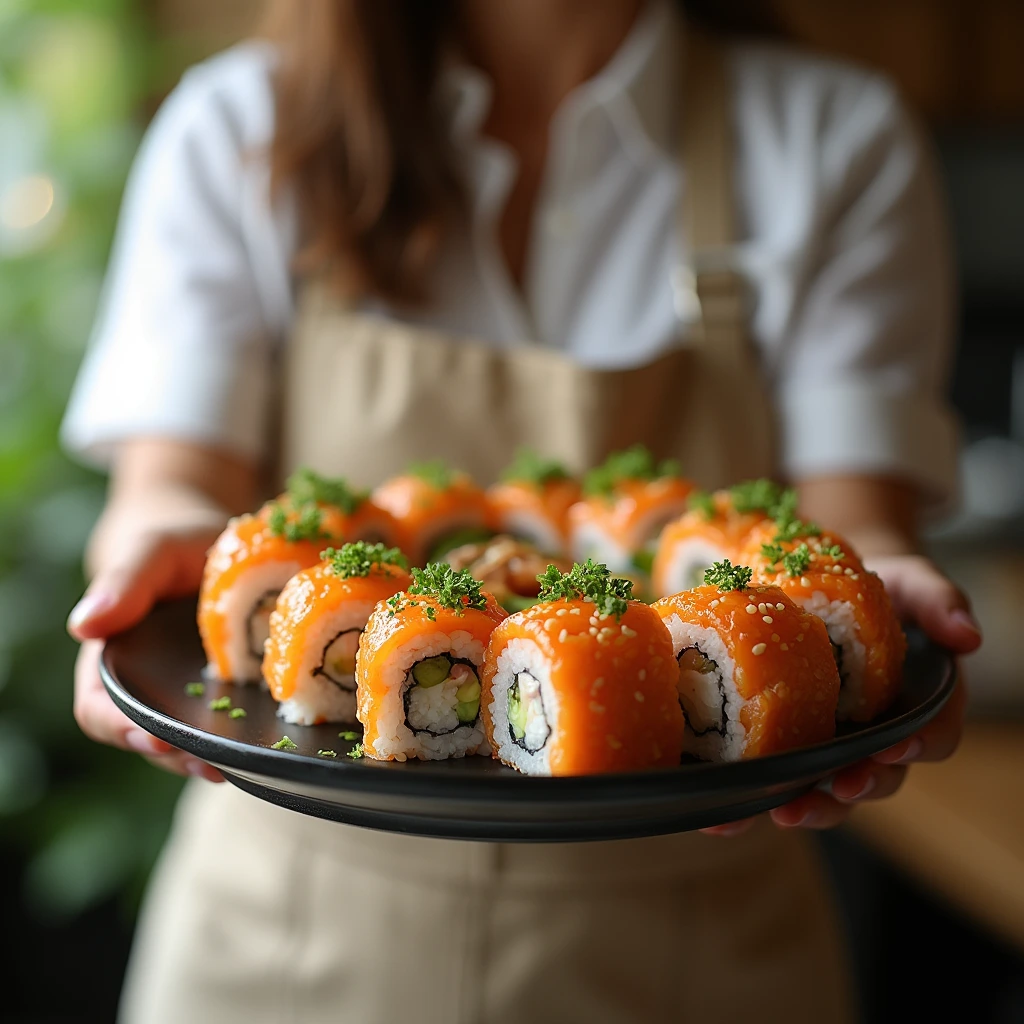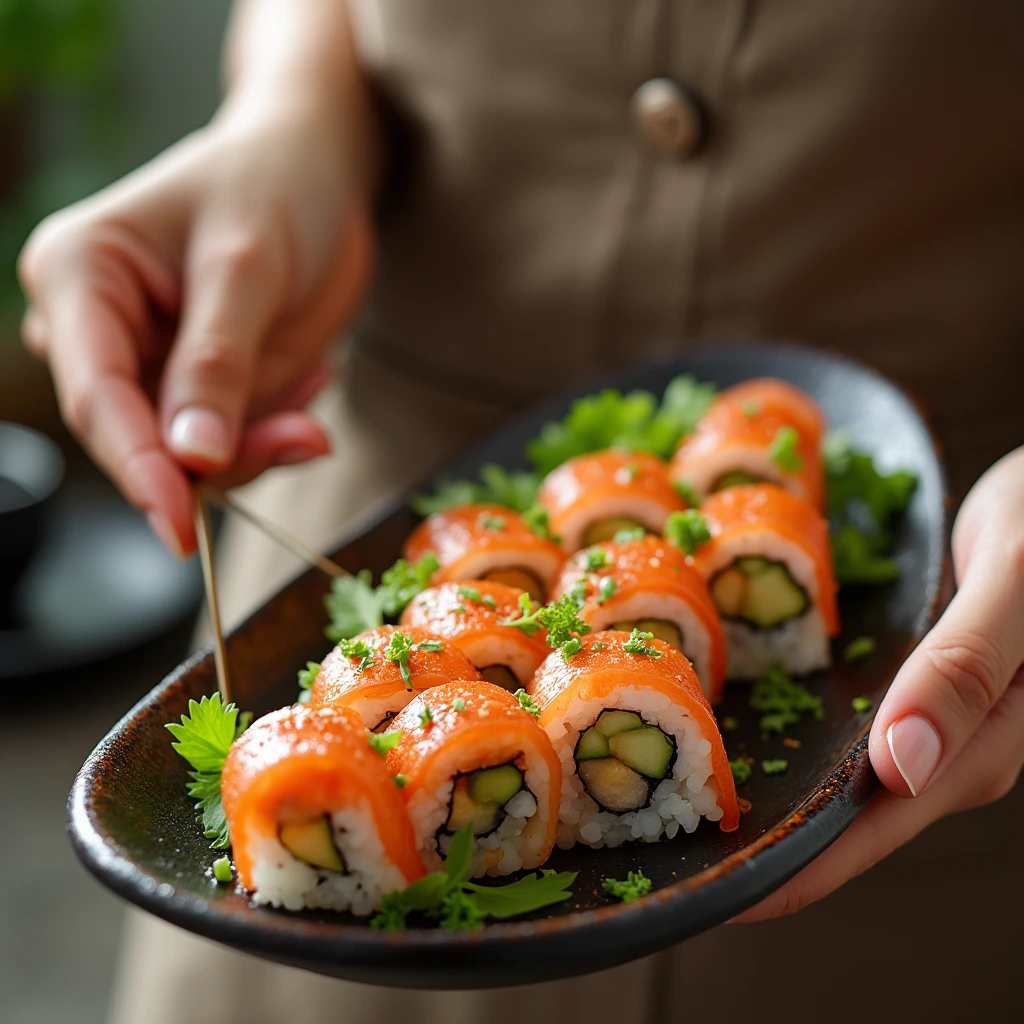Explore the world of sushi rolls and embark on a culinary journey that is unlike any other. In this article, we dive into the art of sushi rolls, teaching you everything you need to know to become a sushi master. From selecting the freshest ingredients to perfecting the delicate art of rolling, we’ll guide you through each step, ensuring that your sushi creations are not only visually stunning but also bursting with flavor.
Thank you for reading this post, don't forget to subscribe!Whether you’re a sushi enthusiast looking to elevate your homemade rolls or a complete beginner eager to learn the basics, our comprehensive guide will equip you with the skills to create the ultimate foodie experience.
Discover the secrets behind classic sushi roll favorites like the California roll, spicy tuna roll, and salmon avocado roll. Learn how to properly prepare and season sushi rice, choose the best seaweed for your rolls, and master the techniques that will take your sushi game to the next level. Get ready to impress your friends and family with your sushi-making prowess and immerse yourself in the vibrant and delicious world of sushi rolls. Let’s roll!
Table of Contents
History and Origins of Sushi
Sushi, a dish that has transcended cultural barriers and captivated food lovers worldwide, has a rich history that dates back centuries. Sushi’s origins can be traced back to ancient Southeast Asia, where a technique of preserving fish in fermented rice was created.
This practice, known as narezushi, involved wrapping fish in rice to ferment it, creating a way to store fish for extended periods. The rice was typically discarded after fermentation, but it laid the groundwork for what would eventually evolve into modern sushi.
As time progressed, sushi began to take on new forms and flavors. By the Edo period in Japan (1603-1868), the concept of sushi transformed significantly. The introduction of vinegar to rice allowed for a quicker preparation method, leading to the creation of nigiri sushi, where a small mound of vinegared rice is topped with a slice of fresh fish.
This innovation not only improved flavor but also made sushi more accessible to the masses. Street vendors in Tokyo began selling nigiri sushi, and it quickly became a popular fast food option among locals.
The 20th century saw sushi’s introduction to the Western world, with sushi bars and restaurants popping up in major cities. The California roll, a fusion roll made with avocado, crab, and cucumber, emerged in the 1960s as a way to cater to American palates.
This marked a significant shift in sushi’s evolution, leading to the creation of countless variations and styles. Today, sushi is celebrated globally, with chefs and home cooks alike experimenting with flavors and ingredients, making it a beloved culinary art form.
Types of Sushi Rolls
Sushi rolls, or maki, are a delightful way to enjoy the flavors of sushi, wrapped in a convenient and visually appealing format. There are several types of sushi rolls that vary in ingredients, preparation methods, and presentation. One of the most popular is the hosomaki, which features a filling, such as cucumber or tuna, wrapped in rice and seaweed. Its small size and simplicity make it an excellent choice for beginners and sushi enthusiasts alike.
Another type is the uramaki, or inside-out roll, which has the rice on the outside and the seaweed on the inside. This style allows for more creativity in presentation, as toppings and garnishes can be added to the rice surface. The California roll is a classic example of uramaki, showcasing the vibrant colors of its ingredients while appealing to those who prefer a milder flavor profile. Uramaki rolls often include a mix of ingredients, such as fresh seafood, avocado, and various vegetables, making them a versatile option.
For those looking for something more substantial, there are temaki rolls, also known as hand rolls. These are cone-shaped rolls filled with rice, fish, and vegetables, allowing for a more casual dining experience as they are meant to be eaten with your hands. Temaki is particularly popular for its ease of preparation and the ability to customize each roll according to personal preferences. With such a variety of sushi rolls available, there is something to satisfy every palate and occasion.



Essential Ingredients for Sushi Rolls
Creating delicious sushi rolls begins with selecting the right ingredients, as they play a vital role in the overall flavor and texture of the dish. The foundation of any sushi roll is sushi rice, or shari, which is prepared using short-grain rice. This type of rice has a higher starch content, allowing it to become sticky when cooked, making it easier to roll and hold its shape. To achieve the perfect sushi rice, it is essential to rinse the rice thoroughly to remove excess starch before cooking, resulting in a fluffy texture.
Another crucial ingredient is nori, the seaweed used to wrap sushi rolls. When choosing nori, opt for high-quality sheets that are dark green and shiny, as they indicate freshness. Good nori will provide a pleasant umami flavor and a slight crunch that complements the other ingredients. Depending on the type of roll being made, various fillings can be incorporated, such as fresh fish like salmon or tuna, vegetables like cucumber and avocado, and even cooked items like shrimp tempura or crab.
Additionally, flavor enhancers such as soy sauce, wasabi, and pickled ginger are essential for elevating the sushi experience. Soy sauce adds a salty depth to the rolls, while wasabi provides a spicy kick. Pickled ginger is a palate cleanser that can help you fully appreciate the unique flavors of each type of sushi. With these essential ingredients on hand, you’ll be well-equipped to embark on your sushi-making journey.
Tools and Equipment Needed for Making Sushi Rolls
To master the art of sushi rolling, having the right tools and equipment is vital. A bamboo sushi mat, or makisu, is one of the most important items you will need. This mat allows you to roll sushi tightly and evenly while maintaining the shape of your rolls. If you’re just starting, consider purchasing a lightweight, flexible mat that makes it easy to practice various rolling techniques.
In addition to the sushi mat, a sharp knife is essential for slicing your rolls with precision. A traditional yanagiba knife is ideal for this purpose, as its long, thin blade allows for clean cuts without squishing the rice or fillings. It’s important to keep your knife wet when cutting sushi rolls to prevent sticking, ensuring that every piece is visually appealing and well-formed.
Other helpful tools include a rice cooker for achieving perfectly cooked sushi rice, a small bowl for mixing vinegar and water to season the rice, and a sushi rice paddle for gently folding the vinegar into the rice. Having these tools organized and within reach will streamline your sushi-making process, allowing you to focus on creating beautiful and delicious rolls.
Step-by-Step Guide to Making Sushi Rolls
Making sushi rolls may seem intimidating at first, but with a step-by-step approach, you can master the technique in no time. Begin by preparing your sushi rice. Rinse 2 cups of short-grain rice under cold water until the water runs clear, then cook it according to your rice cooker’s instructions. Once cooked, transfer the rice to a large bowl and mix in a mixture of rice vinegar, sugar, and salt to season the rice. Allow the rice to cool to room temperature while you prepare your fillings.
Next, lay a sheet of nori, shiny side down, on your bamboo sushi mat. Wet your hands to prevent sticking, then take a small handful of sushi rice and spread it evenly over the nori, leaving about an inch of space at the top. Press the rice down gently but firmly to create an even layer. After spreading the rice, place your chosen fillings horizontally in the center of the rice.
Now comes the rolling process! Begin rolling the sushi by lifting the edge of the mat closest to you, and as you roll it away from you, gently tuck the filling inside. Apply gentle pressure to ensure a tight roll, but be careful not to squish the ingredients. Keep rolling until you reach the uncovered edge of the nori. To seal the roll, dampen the edge of the nori with a little water and press it down gently. Use a sharp knife to slice the roll into bite-sized pieces, wiping the blade with a damp cloth between cuts for clean edges.
Tips and Tricks for Perfecting Your Sushi Rolls
While making sushi rolls is a rewarding experience, there are several tips and tricks that can help you achieve perfection. First, ensure that your sushi rice is seasoned properly not too salty or too sweet. The right balance of vinegar, sugar, and salt will elevate the flavors of the roll and complement the fillings beautifully. Additionally, allow your rice to cool naturally instead of refrigerating it, as this helps maintain its texture and flavor.
When it comes to fillings, don’t be afraid to experiment! While traditional ingredients like fish and vegetables are wonderful, you can also incorporate unique flavors such as cream cheese, spicy mayonnaise, or even fruits like mango for a refreshing twist. The key is to balance textures and flavors, ensuring that each bite offers a delightful experience.
Lastly, practice makes perfect. The more you roll, the better you will become at controlling the pressure and achieving an even roll. Don’t be discouraged by initial attempts; instead, view them as learning experiences. Invite friends or family over for a sushi-making night, encouraging creativity and collaboration as you all explore the art of sushi together.
Popular Sushi Roll Recipes
To inspire your sushi-making journey, here are some popular sushi roll recipes that are sure to impress your friends and family. The California roll is a classic starting point, combining imitation crab, avocado, and cucumber rolled in sushi rice and nori. It’s mild in flavor and perfect for those new to sushi. To prepare, simply layer the fillings on a sheet of rice-covered nori, roll tightly, and slice into bite-sized pieces.
For a spicy kick, try the spicy tuna roll. Mix diced raw tuna with mayo and sriracha for a zesty filling, then roll it up with cucumber and rice. The combination of creamy and spicy flavors makes this roll a favorite among sushi lovers. You can also top it with sliced avocado or spicy mayo for an extra flair.
If you’re craving something indulgent, the tempura roll is an excellent choice. Begin by making tempura shrimp or vegetables, then roll them up with avocado and cucumber for a crunchy texture. This roll is perfect for those who enjoy a little extra crunch and flavor in their sushi. Pair any of these rolls with soy sauce, wasabi, and pickled ginger for a complete sushi experience.
Sushi Etiquette and Dining Customs
Understanding sushi etiquette is essential for enjoying the full sushi experience, especially when dining at a sushi restaurant. One of the key customs is to eat sushi with your hands or chopsticks, depending on your preference. If you’re using chopsticks, avoid sticking them upright in your rice, as this resembles a funeral offering in Japanese culture. Instead, place them on the designated holder or on your plate when not in use.
When dipping sushi in soy sauce, it’s better to dip the fish side rather than the rice, to avoid the rice soaking up too much sauce. This practice allows the delicate flavors of the fish to shine through without being overpowered by salt. Additionally, wasabi can be added directly to the sushi or mixed into the soy sauce, depending on your taste.
Lastly, don’t forget to enjoy pickled ginger between different types of sushi. This acts as a palate cleanser, preparing your taste buds for the next flavor. Embracing these customs not only shows respect for the cuisine but also enhances your overall dining experience, allowing you to appreciate the artistry behind each sushi roll.
Conclusion and Final Thoughts
Embarking on the journey of mastering sushi rolls is both a rewarding and enjoyable experience that allows you to explore your culinary creativity. From understanding the historical roots of sushi to learning the techniques of rolling and the etiquette of dining, each aspect adds depth to your appreciation of this beloved dish. With practice and experimentation, you can create a variety of sushi rolls that showcase not only fresh, high-quality ingredients but also your personal flair.
As you continue to refine your skills, remember that sushi-making is as much about the process as it is about the final product. Enjoy the meditative nature of preparing each ingredient, the joy of rolling, and the satisfaction of sharing your creations with others. Whether you’re hosting a sushi night with friends or simply indulging in your culinary passion, the art of sushi rolls offers a delightful experience that brings people together.
So gather your ingredients, roll up your sleeves, and dive into the vibrant world of sushi rolls. With each roll you create, you’ll not only enhance your culinary repertoire but also share in the joy and flavors that have made sushi a cherished dish across cultures. Happy rolling!
Author’s Top Recipe Picks :
If you’re interested in exploring more delectable dishes, consider trying our guide to anoth
- Muffin Tin Sushi Cups: Easy TikTok Sushi Hack Guide
- How to Master Sushi Rolls: A Step-by-Step Guide for Food Enthusiasts
- Nutritious Healthy Slow Cooker Recipes for a Balanced Diet
sushi rolls

Learn how to master sushi rolls with our step-by-step guide! Discover essential tips, tools, and popular recipes for making delicious homemade sushi
Type: Maki Rolls
Cuisine: Japanese
Keywords: Sushi Rice Tips, Sushi Rice Tips, How to Make Perfect Tempura, How to Make Sushi, Sushi Roll Recipes, Homemade Sushi, Sushi-making Guide, Healthy Sushi Rolls, Sushi History
Recipe Yield: 4 servings
Calories: 300 calories
Preparation Time: PT30M
Cooking Time: PT20M
Total Time: PT50M
Recipe Ingredients:
- Sushi rice: Short-grain rice, sticky, easy to roll, rinse before cooking for fluffy texture.
- Nori: Fresh, dark green, shiny, adds umami flavor and crunch.
- Fillings: Fresh fish (salmon/tuna), vegetables (cucumber/avocado), cooked items (shrimp tempura/crab).
- Flavor enhancers: Soy sauce (saltiness), wasabi (spicy kick), pickled ginger (palate cleanser).
Recipe Instructions: Prepare the Sushi Rice: Rinse 2 cups of short-grain rice under cold water until the water runs clear. Cook the rice according to your rice cooker's instructions. Once cooked, transfer the rice to a large bowl. Mix in a mixture of 1/4 cup rice vinegar, 2 tbsp sugar, and 1 tsp salt. Stir gently to combine. Let the rice cool to room temperature. Prepare the Fillings: Slice the fish (salmon, tuna) into thin strips. Slice vegetables like cucumber and avocado into thin strips. If using cooked ingredients (like shrimp tempura or crab), prepare them as needed. Prepare the Rolling Mat: Lay a bamboo sushi mat (makisu) on a flat surface. Place a sheet of nori (shiny side down) on the mat. Assemble the Roll: Wet your hands to prevent the rice from sticking. Spread a thin layer of sushi rice evenly over the nori, leaving about an inch of space at the top. Add your fillings (fish, veggies, or cooked items) horizontally in the center of the rice. Roll the Sushi: Lift the edge of the mat closest to you and start rolling gently, tucking the fillings inside as you roll. Apply gentle pressure to make the roll tight but not too tight. Once you reach the uncovered edge, dampen it with a little water and press to seal the roll. Cut the Rolls: Using a sharp knife, cut the roll into bite-sized pieces (about 6 pieces per roll). Wipe the knife with a damp cloth between each cut to ensure clean slices. Serve: Arrange the sushi rolls on a plate and serve with soy sauce, wasabi, and pickled ginger on the side.
